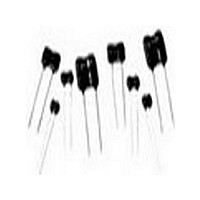CMR03F241JOYM Cornell Dubilier Electronics (CDE), CMR03F241JOYM Datasheet - Page 4

CMR03F241JOYM
Manufacturer Part Number
CMR03F241JOYM
Description
CMR MICA
Manufacturer
Cornell Dubilier Electronics (CDE)
Datasheet
1.CMR03F241JOYM.pdf
(5 pages)
Specifications of CMR03F241JOYM
Capacitance
240pF
Tolerance (+ Or -)
5%
Voltage
50VDC
Mounting Style
Through Hole
Package / Case
Not Required
Construction
Radial
Lead Spacing (nom)
3mm
Military Standard
MIL-PRF-39001
Failure Rate
M
Product Length (mm)
6.9mm
Product Depth (mm)
4.1mm
Product Height (mm)
5.6mm
Product Diameter (mm)
Not Requiredmm
Lead Diameter (nom)
0.4mm
Seated Plane Height
5.6mm
Operating Temp Range
-55C to 125C
Lead Free Status / Rohs Status
Not Compliant
CDE Cornell Dubilier•1605 E. Rodney French Blvd.•New Bedford, MA 02744•Ph: (508)996-8561•Fax: (508)996-3830• www.cde.com
Specifications
Capacitance
when measured at these frequencies:
Dissipation Factor
low. Measure dissipation factor at 1
MHz when the capacitance is 1 pF to
1,000 pF, and at 1 kHz when the ca
pacitance is greater than 1,000 pF. Dis
sipation factor is equal to DF = 2πfRC,
where f is the test frequency, R is the
equivalent series resistance, and C is
the capacitance. For other capacitance
values, see Figure 1.
Quality Factor (Q)
ciprocal of dissipation factor.
Insulation Resistance
pacitances up to 10,000 pF is greater
than 100 G
G
150 °C. For other capacitance values
and temperatures, see Figure 2.
Withstanding Voltage
times the rated voltage, and can be ap
plied up to 5 seconds without damage.
Temperature Coefficient and
Capacitance Drift:
Capacitance
100–1000 pF
1100–3300 pF
3600–9100 pF
10,000 pF
Ÿ
.10
.01
.001
.0001
at 125 °C, and greater than 5 G
1
Maximum dissipation factor
at 1 MHz for capacitance
values of 1,000 pF or less
1–1000 pF @ 1 MHz
Ÿ
> 1000 pF @ 1 kHz
at 25 °C, greater than 10
Figure 1. DF vs. Capacitance
10
is within tolerance
0.0012 max at 1 kHz
0.00075 max at 1 MHz
0.0014 max at 1 kHz
0.0013 max at 1 kHz
limits are be
Dissipation Factor
Measure the
CAPACITANCE (pF)
100
is the re
for ca
is two
Ÿ
1,000
at
Maximum dissipation factor
at 1 kHz for capacitance
values greater than 1,000 pF
10,000
7\SH&05
capacitors’ capacitance at 25 °C, –55 °C,
25 °C, 125 °C (or 150 °C) and at 25 °C af
ter stabilizing at each temperature. The
capacitance will meet the limits of the
Characteristic table shown in Ordering
Information.
Failure Rate:
have specified failure rate levels rang
ing from 0.01% to 1.0% per 1,000
hours. The failure rate level is estab
lished at a 90% confidence level and is
referred to operational life at full-rated
voltage at maximum-rated tempera
ture.
High-Voltage Stabilization:
subject capacitors with Failure Levels
M, P, and R to a burn-in at twice-rated
voltage, at rated temperature, for a
minimum of 48 hours. Capacitors that
show damage, arcing, breakdown, or
low IR are removed. We reject the lot if
more than 8% of the capacitors fail.
Solderability:
steam aging, coat leads with a rosin
flux (R) and immerse in molten
245 °C ±5 °C 60/40 tin/lead solder. Solder
coverage will be no less than 95%
when examined at 10X magnification.
Life Test:
maximum operating temperature
(+125 °C or +150 °C) with 1.5 times rated
voltage applied for 10,000 hours. Take
readings and make visual observations
100,000
Subject the capacitors to
Type CMR capacitors
After an 8-hour
+LJK5HOLDELOLW\0LFD&DSDFLWRUV
100,000
10,000
1,000
100
We
Figure 2. IR vs. Capacitance
5 10
meet the after-test limits on the following page.
every 2,000 hours. There will be no
visual damage and the capacitors will
Resistance to Solvents:
the capacitors to three cycles of 3
minute immersion in solvent, 10 strokes
with bristle brush and, where appli
cable,
202, Method 215. Repeat the three
cycles for three solvent mixtures: Iso
propyl alcohol mixture (Solvent 1),
azeotrope mixture (Solvent 3), and
water/propylene-glycol mixture (Sol
vent 4). The marking will not rub off or
smear and there will be no visible dam
age to the capacitor body. Refer to MIL
STD-202 for details.
Resistance to Soldering Heat:
Capacitors will meet the requirements
of MIL-STD-202, Method 210 Test Con
dition G. Immerse capacitor leads to
within .250 inches (6.4 mm) of the body
in molten tin/lead solder (260 °C±5 °C)
for 10±2 seconds. Allow to cool. Capaci
tors will meet the after-test limits on
the following page.
Marking
method I of MIL-STD-1285, and in
cludes the type designation, “JAN,”
brand, trademark, source code, date
code, rated voltage, capacitance, ca
pacitance tolerance, and highest rated
temperature. Small capacitors are
marked with the letter “J.”
+125°C
+150°C
+25°C
+85°C
1
CAPACITANCE (pF)
/
100
2
minute in vapor, per MIL-STD
of capacitors conforms to
1,000
10,000
Subject
62,000













